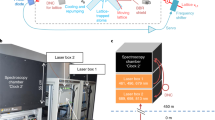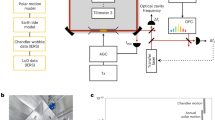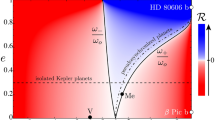Abstract
AN interesting and promising test for the effects of gravitation and motion on the relative rates of a satellite clock and an earthbound clock was proposed four years ago by S. F. Singer1. For this purpose Singer used the Schwarzschild metric for the Earth's field and considered a circular satellite orbit. The neglect of the ellipticity of the Earth has been justified by B. Hoffmann2, provided that the mean radius is used. Neglecting also the rotatory motion of the Earth clock Singer found for the red shift of the satellite clock relative to the Earth clock the expression :  where R is the radius of the Earth, M its mass, h the height of the satellite above the surface of the Earth, and γ and c have their usual meanings.
where R is the radius of the Earth, M its mass, h the height of the satellite above the surface of the Earth, and γ and c have their usual meanings.
This is a preview of subscription content, access via your institution
Access options
Subscribe to this journal
Receive 51 print issues and online access
$199.00 per year
only $3.90 per issue
Buy this article
- Purchase on Springer Link
- Instant access to full article PDF
Prices may be subject to local taxes which are calculated during checkout
Similar content being viewed by others
References
Singer, S. F., Phys. Rev., 104, 11 (1956).
Hoffmann, B., Phys. Rev., 106, 358 (1957).
Nariai, H., and Ueno, Y., Prog. Theor. Phys., 20, 703 (1958).
Bondi, H., and Kilmister, C. W., Amer. J. Phys., 28, 508 (1960).
Author information
Authors and Affiliations
Rights and permissions
About this article
Cite this article
DAVIDSON, W. Use of an Artificial Satellite to test the Clock ‘Paradox’ and General Relativity. Nature 188, 1013–1014 (1960). https://doi.org/10.1038/1881013a0
Issue Date:
DOI: https://doi.org/10.1038/1881013a0
Comments
By submitting a comment you agree to abide by our Terms and Community Guidelines. If you find something abusive or that does not comply with our terms or guidelines please flag it as inappropriate.



